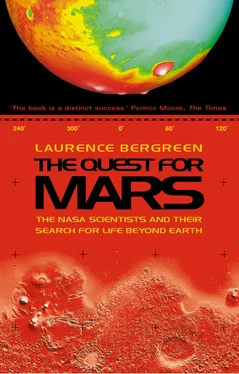They tried to maintain a sense of humor; any joke was better than no joke. The technician who ran the sandbox – the gremlin, they called him – planted toy Martians amid the simulated rocks, and the controllers logged the little creatures as they would in an actual mission. The tests increased in frequency until they took place nearly all the time, and Bridget, for one, felt overwhelmed by the intensity. “I refer to this as ‘a snake swallowing a gopher’: it is an enormous amount of data/work/whatever, and it can be tracked visibly as the lump makes its way through the system.”
By this point, the team members had left terrestrial time behind; they lived on Martian time. A Martian day, or sol, is forty minutes longer than an Earth day; every twenty-four hours, the team migrated forty minutes around the clock to remain in synchronization with the Red Planet. The time shift was very disorienting; after a while, they began to feel as though they were living on Mars. “I had no clue as to what time it was on Earth, although I could tell you what sol it was,” Bridget recorded. “I even tried to date a check with the sol number during this time, and I dated leftover food in the refrigerator with the sol. I totally lost track of time. I couldn’t tell you what planet I was on, never mind what day it was. I was often surprised to walk out of JPL and find the sun up.” While she worked the graveyard shift, she found it “strange to be driving home under rosy skies, pulling the pillow over my head to shut out the morning light. Stranger still to hear meetings called for midnight or 2 AM, and having to ask whether an event scheduled for 6 means AM or PM.” One night, while driving home on the freeway, Bridget fell asleep at the wheel. There was no accident, no one was hurt, fortunately, but the mishap terrified her. After that, she kept a sleeping bag and pillow in her office so she could sleep there, if she needed.
Bridget’s role on Pathfinder changed along with her schedule, and throughout the project, she never knew what to expect. Her first job was straightforward: adapting sequencing software to Pathfinder’s commands and instruments, but then she worked with the imaging team in a job so idiosyncratic there wasn’t even a name for it. For official purposes, she called herself an Uplink System Engineer, but the title didn’t begin to describe the nuances of the position. After a while, she came to see the benefits of this elastic, improvisational approach; it was liberating, as long as she could keep up with it. “I think this is the main reason we succeeded – there was so little redundancy in staff and hardware that you had to understand not only your little piece of the puzzle, but how it all fit together. There was no one else to do it. If people couldn’t think this way, they left.” She managed to hang on, but found her new job staggeringly intricate and pressured. If just one system on which she worked malfunctioned, the entire mission could go haywire. “I always mean to go back and clean up the code I write, but there is only so much time and money and energy – you do the things that matter most, until it’s good enough. Striving for perfection is a good and worthwhile effort. Expecting actually to attain perfection can kill you.”
What started out as a cool new job – but still, just a job – became much more than that to Bridget and to the other team members. Most were young, this was their first big mission, in some cases their first job at NASA, and while they were confident of their technical skills, which was the reason they were hired in the first place, they were less certain they could manage the emotional strain. That was something they didn’t teach you back at Caltech or MIT: how to deal with failure and uncertainty. “This is a nerve-wracking experience,” Rob Manning confided in his journal. “It is really tough to go to another planet.” Normally a jovial soul, Rob endured nightmares. In one, “I launched my dog Scooter up in the spacecraft, and it landed on Mars. I realized, too late, how was I going to get him home? I was really upset for letting him go!”
On Monday, June 23, David Mittman, the new Pathfinder flight controller, awoke at three o’clock in the morning and showered in the dark so as not to disturb his sleeping family. He had managed a few minutes extra sleep by shaving the night before. He dressed, and drove to work at JPL. The place was already alive; June 23 was going to be a crucial day in the life of Pathfinder, which would land on Mars on July 4. “All the flight engineers have been developing ‘sequences’ – collections of commands executed in order by the spacecraft – in preparation for landing,” he wrote. “These sequences have gone through many reviews and revisions. Some sequences have been changed as many as twenty times as we’ve learned more about how to operate Mars Pathfinder.” Mittman and his team were about to send nearly 300 sequences to Pathfinder via the Deep Space Network’s transmitter in Madrid. The task was time consuming, because each sequence, traveling at the speed of light, as fast as anything can go in the universe, required nine minutes and forty seconds to reach Pathfinder as it sped toward Mars. The transmission proceeded smoothly for nearly twelve hours, until glitches in terrestrial equipment halted the proceedings.
Конец ознакомительного фрагмента.
Текст предоставлен ООО «ЛитРес».
Прочитайте эту книгу целиком, купив полную легальную версию на ЛитРес.
Безопасно оплатить книгу можно банковской картой Visa, MasterCard, Maestro, со счета мобильного телефона, с платежного терминала, в салоне МТС или Связной, через PayPal, WebMoney, Яндекс.Деньги, QIWI Кошелек, бонусными картами или другим удобным Вам способом.












